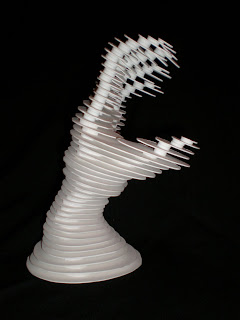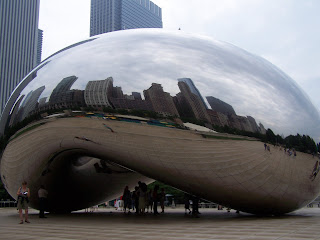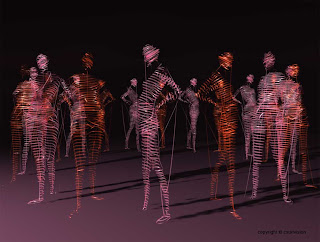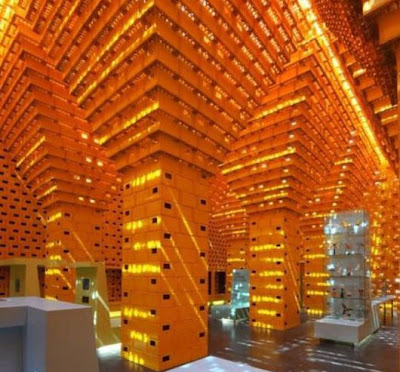For my final serial plane project I was interested in creating a juxtaposition with the use of terracycle. I found a variety of everyday materials such as denim, laminated paper used for magazine covers, PreWrap medical tape, cardboard, and processed food bags and bottle labels (these are all glued into my sketchbook). While researching pictures for serial planes for my second reading homework assignment, I came across these serial plane hand sculptures. These thoroughly intrigued me, with their use of placement of the planes, the angle of them, and space surrounding the planes to create a 3D hand sculpture. I also really enjoyed the recycled popcorn bags that we experimented with in class. I think juxtaposition helps a piece to be very successful if it is balanced right. For this piece, I had the idea of creating a hand made entirely out of serial planes with the actual hand in an upward cupping motion. The juxtaposition (and terracycle) is applied on the actual materials being used. For the planes, I am using recycled cardboard as well as recycled Smartfood popcorn bags. The apple that will be held up in the hand will be constructed also out of recycled cardboard but with glued on laminated paper (simulated texture of an apple touch-wise).
Sunday, March 31, 2013
Friday, March 29, 2013
Artist of the Week (Week 9 of March 25)
Liu Bolin
Liu Bolin is a Chinese artist known for his work in camouflage art (also known as "invisible art"). His work burst onto the art scene in 2007 and was dubbed as "advanced camouflage work." Almost all of his pieces show him being seamlessly blended into whatever elaborate background he has chosen. To produce his work, him and two assistants spend hours painting directly onto his clothes and body. They then place him into the perfect position to disappear into the backdrop. Bolin has noted that this line of work was the result of the Chinese government closing his place of employment, the Suoija Village Art Campus, and him deciding to find his own path. Below are images from his new project Hiding in the City that is being feautured at the Eli Klein Gallery in New York City.
Sources:
Tuesday, March 26, 2013
Weekly Quotation 9:
"The beautiful is always bizarre."
-Charles Baudelaire: French poet, essayist, art critic, and translator
This quotation initially caught my attention with its short, yet powerful message. At first reading, it sounds like Baudelaire is saying that everything that is beautiful is unusual. However, after thinking further I think he is referencing to how things that people find beautiful are uncommon, because whatever is beautiful doesn't show up enough in their life. For instance, people all have different attractions to art. If all art in the world were aesthetically pleasing to everyone, then people would more likely find unappealing art in the visual sense more intriguing because it would be different, out of place, and interesting. My interpretation of Baudelaire's quotation is ultimately that beauty is relative to the viewer, therefore those who do not find whatever the viewer finds beautiful, act as a as a balanced counterpart. This balance acts as a way to make the beauty even more beautiful to the viewer.
Sampling of Baudelaire's Work:
Les Fleurs du Mal (1857)
Les Paradis Artificiels (1860)
Monday, March 25, 2013
Sunday, March 24, 2013
Progress - Project 1 - Chess Pieces
My partner Brittany and I finally got to working on the individual pieces for our paper chess set we constructed for Project 1. Below are the schematics of each piece (pawn, horse, bishop, rook, queen, and king).
Pawn and Horse
Bishop and Rook
Queen and King
Note: Pictures of actual pieces will be posted shortly
Tuesday, March 19, 2013
Weekly Quotation 8:
"An artist is always alone - if he is an artist.
No, what the artist needs is loneliness."
No, what the artist needs is loneliness."
-Henry Miller: American writer and painter
This quotation has always intrigued me immensely. The way I interpret this quotation is that an artist or designer must first put their work first if they wish to be successful. To do this, the artist or designer needs to seclude themselves from others to really be able to submerge themselves in their work. I agree with Miller's statement in the sense of this being applied to work that is for one's personal gain. When I am working on projects for school that hold no emotional meaning to me, I tend to work in the presence of a friend so I do not get distracted and slack off. However, when I am working on a project that holds emotional value to me, I find myself needing to distance myself from others to eliminate distractions and be able to look deep inside myself to pull out the emotions I want to convey in my art.
Sampling of Miller's Work:
Three Figures, watercolor. Date unknown.
Sunday, March 17, 2013
Reading Assignment II
1. Describe interaction and stability in 3-D form. What is the “three plane rule?” Give an example?
Robert Murray, Wasahaban, painted aluminum. 1978.
2. What is an environmental plane and planar structure? Give examples and describe it.
Bohlin Cywinski Architects, Modern Suburban House. 2010.
3. Define an architectonic form. List three examples given in the reading: (A). (B). (C.)
These forms are often found in furniture and architecture. Their features include:
Arnolfo di Cambio / Filippo Brunelleschi, Basilica di Santa Maria del Fiore. Florence, Italy, 1436.
4. How can a reflective surface effect the transition of space?
5. How can planes define volume?
6. Describe the following organizational principles that relate to 3 dimensional forms:
1. Organization-
2. Synergy
Casey Vidalenc, Synergy in Fashion, interwoven strings and ropes. 2011.
3. Order and freedom
4. Structure and unity
5. Symmetry
6. Repetition within variety
7. Rhythm and gradation
- Two planar forms have the ability to interact with each other in three different ways. The first is they can meet at a common edge, such as a fold. The second is that one edge of a plane can abut or be adjacent to the face of another. The third is that the two planes can interpenetrate, or pass through one another.
- The three plane rule is "a stable structure results when any three planes meet so that each plane interacts with both of the other planes."
Robert Murray, Wasahaban, painted aluminum. 1978.
- An environmental plane defines a space in which the planar object is experienced.
- The combination to make one unified structure is the planar structure.
Bohlin Cywinski Architects, Modern Suburban House. 2010.
These forms are often found in furniture and architecture. Their features include:
- Geometric shapes such as rectangles, triangles, and circles.
- Primary emphasis on horizontal and vertical orientations as well as orthogonal placements.
- Contrast of closed (interior) and open (exterior) space with emphasis on these two types of space.
Arnolfo di Cambio / Filippo Brunelleschi, Basilica di Santa Maria del Fiore. Florence, Italy, 1436.
Note the use of geometric shapes, emphasis on horizontals and verticals,
and the contrast of interior and exteriors, especially in the windows.
4. How can a reflective surface effect the transition of space?
- Reflective surfaces create an illusion of space entering into a closed surface, therefore they possess the ability to effect the transition of space.
Anish Kapoor, Cloud Gate, steel. Chicago, USA, 2004-06.
- Planes define volume by their virtue or shape, such as many intersecting circles of the same shape with the same center set at different angles make a sphere.
Sphere shown with intersecting planes which make up the volume
6. Describe the following organizational principles that relate to 3 dimensional forms:
1. Organization-
- The overall structure or pattern which combines parts of an object together into a united, sensible, and purposeful whole. A design's organization derives from its purposes, meanings, and functions of its overall intention.
Charles A. Csuri, The Frozen Moment, virtual glass. 1999-2001.
- Derives from the organization of separately unimpressive elements which join to create an outcome greater than expected.
Casey Vidalenc, Synergy in Fashion, interwoven strings and ropes. 2011.
- In design, there needs to be a balance between order and freedom to create unity and richness in a composition. It is necessary to think about which one to choose to emphasize to achieve success in the composition.
Numen / For Use Collective, Tape Melbourne, mixed materials. Melbourne, Australia, 2011.
- The effective use of unified principles help to create a systematic structure. These principles which include balance, repetition with variety, proportion, continuity, focus and emphasis, and economy visually bind together a composition.
Jürgen Mayer-Hermann, Metropol Parasol, wood. Seville, Spain, 2005-2011.
- Bilateral (mirrored) is the most common type of symmetry and is when one half of a composition is reflected either horizontally or vertically in the other half.
Ustad Ahmad Lahauri, Taj Mahal. Agra, India, 1632-1653.
- Radial symmetry relates to the use of repeated forms that radiate from a central axis.
John Augustus Roebling, The Brooklyn Bridge. New York, USA, 1883.
6. Repetition within variety
- Repetition produces order in a composition, but having an excessive amount creates blandness. Therefore variety must be present to keep the viewer's attention. Strong unity within a design derives from repeating compositional elements of specific relationships.
Akio Hizume, Fibonacci Tunnel, bamboo. Tokyo, Japan, 2008.
- Along with variety, these two forms use the systematic repetitions of intervals of change.
Daniel Rozen, Circles Mirror, digitally printed circles with motors and other electronics. 2005.
Source: Leucking, Steven. Principles of Three-Dimensional Design: Objects, Space, and Meaning
Thursday, March 14, 2013
Artist of the Week (7th Week of Mar 11)
Julian Beever
Julian Beever is an English chalk artist who creates tromp l'oeil sidewalk art that takes on a 3-Dimensional nature. He uses anamorphosis, a projection technique to create this effect. Each artwork must be viewed from a designated point to get the full effect, but it is possible for people to interact with the work. In 2000, his work became well-known and has been referred to occasionally as the "Pavement Picasso." Besides his pavement art, he paints murals with acrylic paints, re-works of the art masters' paintings in oil paint, as well as music-related drawings. He released his book Pavement Chalk Artist in 2010. The book documents his sidewalk art from around the world through photographs. He is currently in high demand from corporate businesses and he credits the internet to his international success. Below are some of his sidewalk masterpieces.
Beever interacting in his piece Monkey Pit. Madrid, Spain.
Meeting Mr. Butterfly. Mexico City, Mexico.
Explosion in Paris. Paris, France.
A Slight Accident on a Building. Vienna, Austria
Times Square. Times Square, New York.
Taking the Plunge. Montreal, Canada.
Make Poverty History. Edinburgh, Scotland.
Make Poverty Histor viewed from the wrong angle
Sources:
Wednesday, March 13, 2013
3 Art Pieces (7th Week of Mar 11)
This week I decided to focus on pavilion design. These are a few different designs I found while searching through articles on my Flipboard app. Personally, I feel like there is something extremely intriguing about pavilion design. It may be because while the structure is not an actual building, it is interactive to the viewer in the sense that they can walk through it.
Martin Saarinen, Lignum Pavilion, wood. 2010.
Full View
Interior View
MATSYS, Shellstar Pavilion, Coroplast. Hong-Kong, China, 2013.
Full View
Interior View
SHSH Firm, Beer Crate Pavilion, recycled beer crates. Brussels, Belgium, 2008.
Full View
Interior View
Tuesday, March 12, 2013
Weekly Quotation 7:
"Art enables us to find ourselves
and lose ourselves at the same time."
-Thomas Merton: American Trappist monk, writer, poet, and social activist
This is my all time favorite quotation relating to art. When I looked up the person who declared this, I was very surprised to find that he did not practice visual art at all. In a way, it was shocking to discover that a man who was not a visual artist could make a statement that basically summed up my entire view on what art is in one sentence. To me, art is more of an emotional practice (albeit the foundation you need to first build to make your art successful). People create visual art for a multitude of reasons, but at the core, it is because people want to express themselves in a way that can be observed by viewers. This being said, what I believe Merton is describing is the emotional journey that each artist experiences when creating a piece of art. This emotional journey entails a person being able to lose themselves in their mind to be able to pull out the emotions they want to convey in their work. At the end of this journey, the finished piece of art is the "finding yourself" part because the piece documents your feelings and therefore acts as a personal explanation to what you were feeling.
Sampling of Merton's Works:
Thirty Poems (1944)
A Man in the Divided Sea (1946)
The Seven Storey Mountain (1948)
No Man Is an Island (1955)*
The Silent Life (1957)
Seeds of Destruction (1964)
My Argument with the Gestapo: A Macaronic Journal (1969)
The Asian Journal of Thomas Merton (1973)
The Non-Violent Alternative (1980)
*Above quotation cited here
Thursday, March 7, 2013
Artist of the Week (6th Week of Mar 4)
DOS Architects
DOS Architects is an English architecture group with their office set in London, UK. The directors are Lorenzo Grifantini and Tavis Wright. These two men have impressive credentials of working with large architecture firms such as Foster and Partners, Atelier Philipe Starck, Zaha Hadid Architects, and Ron Arad Associates. The group is committed to delivering consistent, detailed, and punctual work to private companies and developers. DOS Architects have designed very modernistic and curvelinear-baesd buildings such as hotels, office buildings, churches, and residential homes. Below are a few of their projects.
Souldern Rd Residential Home. London, UK, 2006.
Catholic Church of the Transfiguration. Lagos, Nigeria, 2011
Olympic Swimming Pool. Erbil, Kurdistan, 2013.
Sources:
Wednesday, March 6, 2013
3 Art Pieces (6th Week of Mar 4)
This week I decided to focus on outdoor sculpture design. I personally find sculpture challenging when creating it myself because I feel as if my creations are more pieces of craft, rather than works of art. While I do not practice sculpture myself, I still have a great appreciation for it, and I like admiring different types, such as marble portraits or abstract metal structures. I may not be able to create sculpture and understand it, but I can recognize aesthetics and appreciate as such.
Jonathon Borofsky, Walking to the Sky, stainless steel. Pittsburgh, USA, 2006.
Full view
Detail
Kader Attia, Reflective Tombstones, glass mirrors. 2013.
Full View
Detail
Philip Haas, The Four Seasons, natural materials. New York, USA, 2013.
Full View
Detail
Subscribe to:
Comments (Atom)
































.jpeg)



